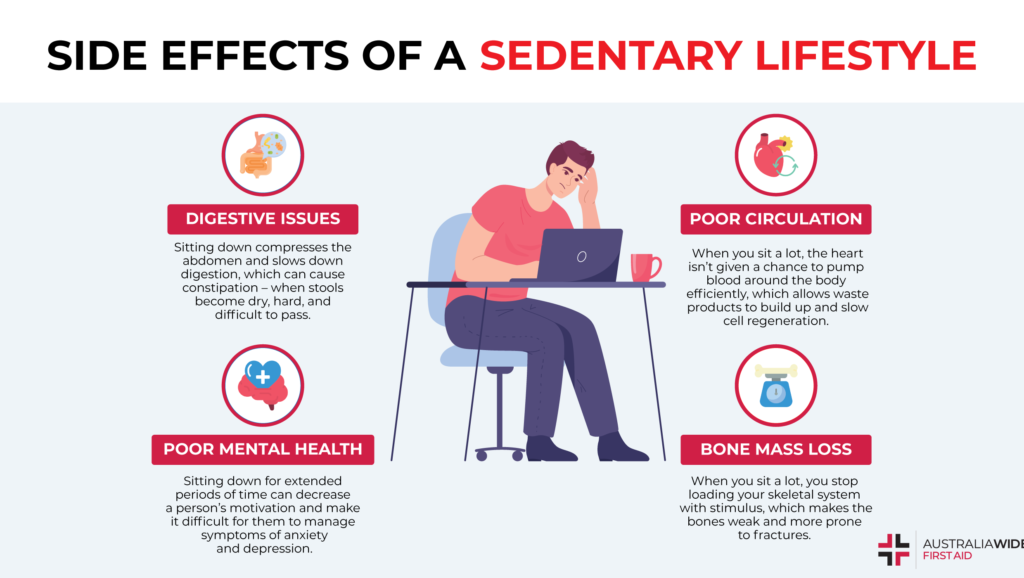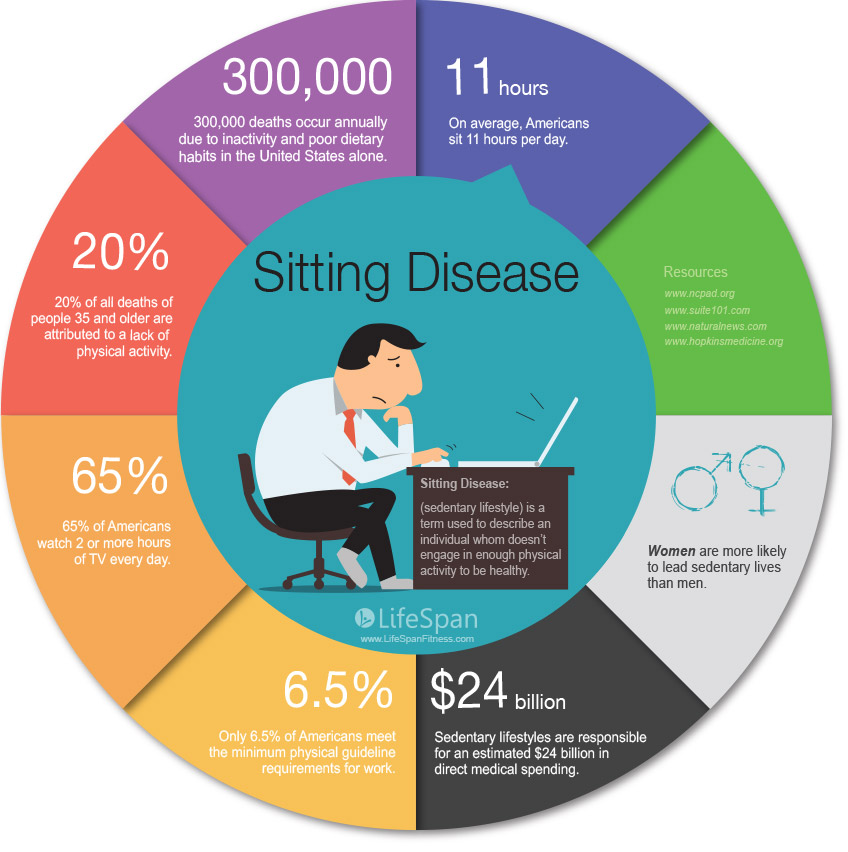
Living a sedentary lifestyle may seem harmless, but it comes with a host of health risks that can have long-lasting and detrimental effects on your well-being. From weight gain and increased risk of chronic diseases like heart disease and diabetes, to weakened muscles and bones, the consequences of a sedentary lifestyle are far-reaching. This article will shed light on the various health risks associated with leading a sedentary life, serving as a wake-up call to prioritize the importance of physical activity and movement in your daily routine.
Cardiovascular Health
Increased Risk of Heart Disease
Living a sedentary lifestyle significantly increases your risk of developing heart disease. When you spend extended periods sitting or being inactive, your heart has to work harder to pump blood throughout your body. This can lead to an accumulation of fatty deposits in your blood vessels, causing a condition known as atherosclerosis. Atherosclerosis narrows your arteries and reduces blood flow, putting you at a higher risk of heart attacks and other cardiovascular events.
Higher Chances of Stroke
Inactivity also increases your chances of experiencing a stroke. When you lead a sedentary lifestyle, the blood flow to your brain becomes compromised, making it more likely for blood clots to form and block the flow of oxygen to your brain. This can result in a stroke, which can have severe and long-lasting effects on your physical and cognitive abilities.
Elevated Blood Pressure
Engaging in physical activities and exercise keeps your blood pressure in check, but a sedentary lifestyle can cause an elevation in blood pressure levels. When you’re inactive, your blood vessels become less efficient at regulating blood flow, leading to higher blood pressure. This puts added strain on your heart and increases the risk of developing hypertension, which can lead to various cardiovascular problems if left untreated.
Obesity and Weight Gain
Higher Body Fat Percentage
One of the most obvious consequences of a sedentary lifestyle is weight gain. When you spend most of your time sitting or engaging in minimal physical activity, your body burns fewer calories. This can lead to an increase in body fat percentage, as the excess calories are stored as fat. Over time, this can result in obesity, which further exacerbates the risk of various health issues.
Increased Risk of Diabetes
Obesity and weight gain caused by a sedentary lifestyle can lead to insulin resistance, a condition where your cells are less responsive to insulin. This can result in elevated blood sugar levels and eventually lead to the development of type 2 diabetes. Regular exercise and physical activity help regulate blood sugar levels and improve insulin sensitivity, but a lack thereof increases the risk of diabetes significantly.
Slowed Metabolism
Leading a sedentary lifestyle can negatively impact your metabolism, making it more difficult for your body to burn calories efficiently. Regular physical activity helps boost your metabolism, allowing you to burn calories even at rest. However, when you’re inactive, your metabolic rate slows down, making it easier for weight gain and harder to lose weight.

This image is property of images.healthonics.healthcare.
Musculoskeletal Issues
Muscle Weakness and Loss
A sedentary lifestyle can contribute to muscle weakness and loss. When you don’t use your muscles regularly through activities such as exercise, they start to atrophy. This can lead to decreased muscle mass, strength, and overall endurance. Weak muscles are more prone to injuries and can make daily tasks more challenging.
Poor Bone Health
Regular weight-bearing exercises, such as walking or weightlifting, are essential for maintaining healthy bones. When you lead a sedentary lifestyle, your bones are not subjected to enough stress to stimulate new bone growth. Over time, this can lead to decreased bone density, making you more susceptible to fractures and osteoporosis.
Increased Risk of Osteoporosis
Osteoporosis is a condition where your bones become weak and brittle. Prolonged sitting or lack of physical activity can accelerate the loss of bone density, putting you at a higher risk of developing osteoporosis. This can be particularly concerning for older individuals who are already at a higher risk of falls and fractures.
Mental Health Concerns
Higher Risk of Depression and Anxiety
A sedentary lifestyle can have a profound impact on your mental health. Studies have shown that individuals who are less physically active are more likely to experience symptoms of depression and anxiety. Physical activity releases endorphins, which are natural mood boosters and help alleviate symptoms of these mental health conditions. Without regular exercise, your brain may not receive adequate levels of these feel-good chemicals, leading to an increased risk of depression and anxiety.
Cognitive Decline
Engaging in regular physical activity has been linked to improved cognitive function and a reduced risk of cognitive decline. Conversely, a sedentary lifestyle can contribute to a decline in cognitive abilities, including memory, attention, and problem-solving skills. Physical activity promotes blood flow to the brain and the growth of new neurons, strengthening the connections among brain cells. Without exercise, these cognitive processes may suffer, potentially leading to cognitive decline over time.
Decreased Overall Well-being
Leading a sedentary lifestyle can negatively impact your overall well-being. Physical activity not only improves physical health but also enhances your mood, boosts self-esteem, and promotes a sense of accomplishment. Without regular exercise, you may feel more sluggish, less motivated, and generally less satisfied with life. Prioritizing physical activity and incorporating it into your daily routine can significantly contribute to a higher overall sense of well-being.

This image is property of www.australiawidefirstaid.com.au.
Hormonal Imbalances
Altered Insulin Production
A sedentary lifestyle can disrupt insulin production in your body. Regular exercise helps regulate insulin levels and improve insulin sensitivity, allowing your body to effectively utilize glucose for energy. However, a lack of physical activity can impair insulin production and lead to insulin resistance, increasing the risk of type 2 diabetes and other metabolic disorders.
Impaired Testosterone Levels
Physical activity has been shown to boost testosterone levels, an essential hormone in both men and women. Testosterone plays a vital role in maintaining muscle mass, bone density, and overall vitality. When you lead a sedentary lifestyle, your testosterone levels may decline, potentially leading to muscle loss, decreased libido, and fatigue.
Disrupted Menstrual Health
In women, a sedentary lifestyle can disrupt menstrual health. Hormonal imbalances, often caused by excessive sitting and lack of physical activity, can lead to irregular periods, reduced fertility, and increased menstrual pain. Engaging in regular exercise can help regulate hormone levels and improve overall reproductive health.
Digestive Problems
Sluggish Bowel Movements
A sedentary lifestyle can contribute to sluggish bowel movements and increase the risk of constipation. Physical activity stimulates the muscles in your intestines, helping move waste through your digestive system. Without regular exercise, your intestinal muscles may become weak, resulting in slower bowel movements and difficulties passing stool.
Higher Risk of Colon Cancer
Limited physical activity and prolonged sitting have been associated with an increased risk of colon cancer. Regular exercise helps reduce the time it takes for food to move through the colon, minimizing the exposure of your intestinal cells to potentially harmful substances. Additionally, physical activity boosts the production of antioxidants and strengthens your immune system, which can help protect against the development of cancerous cells.
Increased Risk of Acid Reflux
A sedentary lifestyle can contribute to the development of acid reflux, a condition where stomach acid flows back into the esophagus, causing heartburn and discomfort. Physical activity helps improve digestion and promotes a healthy weight, both of which can minimize the risk of acid reflux. Without regular exercise, the likelihood of experiencing this uncomfortable condition increases.

Weakened Immune System
Reduced Immune Response
Regular exercise has been shown to enhance the immune system, helping your body fight off infections and diseases. On the other hand, a sedentary lifestyle weakens your immune system, making you more susceptible to illnesses. Lack of physical activity can slow down the production of immune cells and decrease their efficiency, leaving you more vulnerable to infections.
Susceptibility to Infections
When you lead a sedentary lifestyle, your body’s ability to fight off infections becomes compromised. Regular exercise boosts circulation, helping immune cells circulate more efficiently throughout your body. This reduces the risk of infections and helps your body respond promptly to invading pathogens. Conversely, a sedentary lifestyle can leave you more susceptible to bacterial and viral infections.
Delayed Healing
Regular physical activity promotes better wound healing and tissue repair. Exercise increases blood flow to injured areas, delivering oxygen and nutrients crucial for healing. However, a sedentary lifestyle slows down this healing process, as the lack of physical activity restricts blood flow and deprives injured tissues of the necessary resources to recover.
Poor Circulation
Restricted Blood Flow
Sitting for extended periods can restrict blood flow, especially to the lower extremities. This can result in poor circulation, leading to sensations of numbness, tingling, or coldness in your legs and feet. Restricted blood flow can also contribute to the development of blood clots, increasing the risk of deep vein thrombosis (DVT) and other circulatory problems.
Increased Clotting Risk
A sedentary lifestyle increases the chances of blood clots forming in your veins, particularly in your legs. Prolonged sitting or inactivity can cause blood to pool in your legs, increasing the likelihood of clot formation. If a clot dislodges and travels through your bloodstream, it can potentially block blood flow to vital organs, leading to life-threatening complications.
Varicose Veins
Varicose veins are enlarged, twisted veins that often develop in the legs. Prolonged sitting or a lack of physical activity can contribute to the development of varicose veins. Regular exercise helps improve circulation and promotes the efficient return of blood to the heart, reducing the risk of varicose veins.

This image is property of images.lifespanfitness.com.
Increased Risk of Certain Cancers
Higher Likelihood of Breast Cancer
Multiple studies have shown a correlation between a sedentary lifestyle and an increased risk of breast cancer. Regular physical activity is believed to lower estrogen levels, a hormone that can fuel the growth of certain breast cancers. Engaging in moderate exercise, such as brisk walking or cycling, can help reduce this risk and improve overall breast health.
Heightened Risk of Colon Cancer
A sedentary lifestyle has been linked to a higher risk of colon cancer. Prolonged sitting and lack of physical activity can lead to slower digestion, increased inflammation, and changes in the gut microbiome, all of which can contribute to the development of colon cancer. Regular exercise and maintaining a healthy weight can help reduce the risk of this potentially life-threatening disease.
Increased Risk of Lung Cancer
While smoking is the leading cause of lung cancer, a sedentary lifestyle can also increase the risk. Studies have found that individuals who spend long hours sitting have a higher likelihood of developing lung cancer, even when controlling for factors such as smoking. Engaging in regular exercise and avoiding prolonged periods of sitting can reduce the risk of this deadly disease.
Negative Impact on Longevity
Lower Life Expectancy
Living a sedentary lifestyle is associated with a lower life expectancy. Numerous studies have found a direct link between prolonged sitting and an increased risk of premature death. Lack of physical activity contributes to the development of various chronic diseases, including heart disease, cancer, and diabetes, all of which can shorten your lifespan.
Higher Mortality Rates
Sedentary behavior increases mortality rates, particularly from cardiovascular diseases and certain types of cancer. Leading a sedentary lifestyle not only raises the risk of developing these diseases but also increases the likelihood of experiencing complications and a poorer prognosis if diagnosed. Regular physical activity is crucial for improving survival rates and overall longevity.
Increased Risk of Premature Death
Perhaps the most alarming consequence of a sedentary lifestyle is the increased risk of premature death. Engaging in physical activity not only improves your overall health but also adds years to your life. Conversely, a sedentary lifestyle shortens your lifespan and raises the chances of dying prematurely. Prioritizing regular exercise and reducing sedentary behavior are essential for promoting a longer, healthier life.
In conclusion, leading a sedentary lifestyle poses numerous risks to your health and well-being. From cardiovascular problems to mental health concerns, hormonal imbalances to weakened immunity, the negative consequences of a sedentary lifestyle are far-reaching. It is crucial to incorporate regular physical activity into your daily routine, regardless of age or fitness level. By reducing sedentary behavior and adopting an active lifestyle, you can significantly improve your overall health, longevity, and quality of life.

This image is property of images.medindia.net.